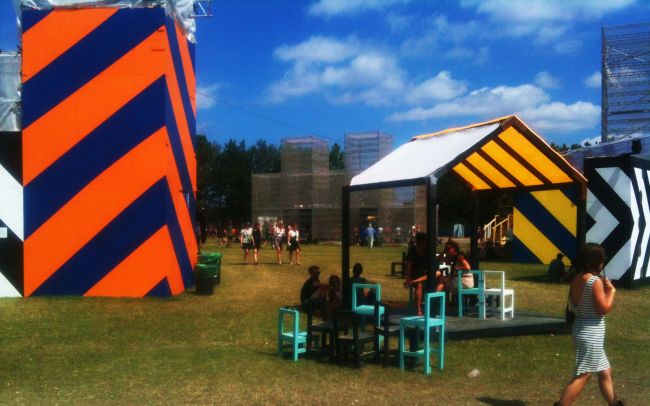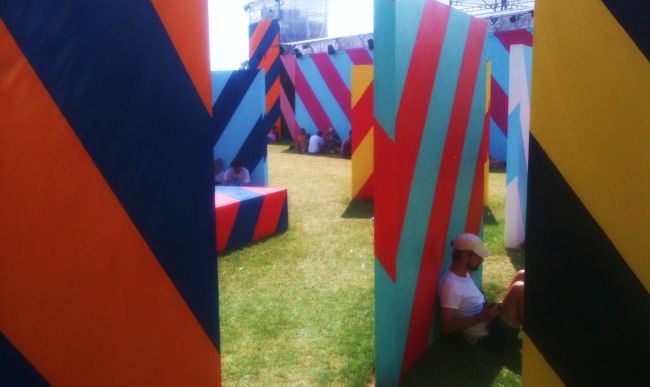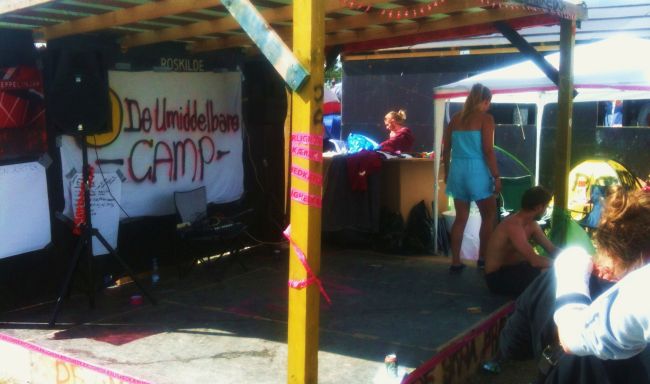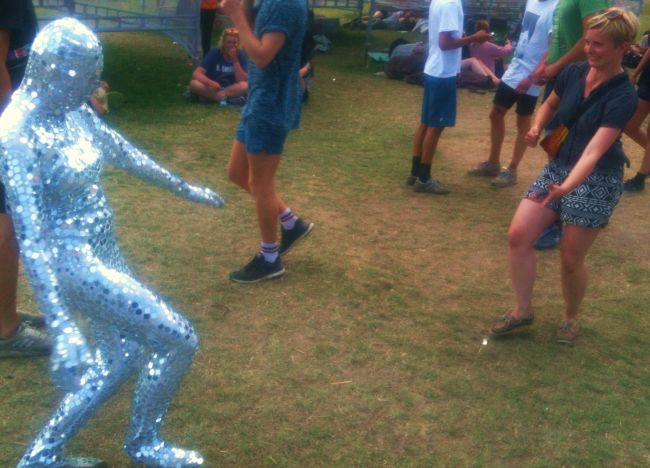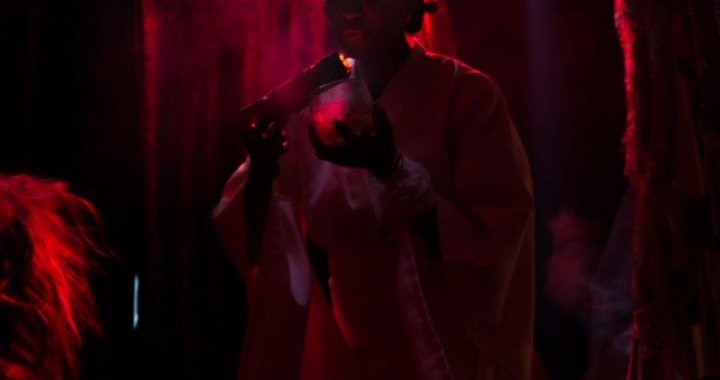
“Falling in love with foxes” - The art world of Roskilde Festival 2014
Roskilde Festival is breaking new ground for festival art. Come along for a tour of its fast-developing art scene...
Jacob Stubbe Østergaard
21/07/2014
"Do you think desire has an end?"
I run my hands along the feathers on the wall.
"No", I reply.
Where am I? What's happening to me?
"...whenever a desire is fulfilled, it regenerates.", I continue.
"What do you think?", I ask the fox.
WHO am I? What will happen next?
"I think the object may change but the desire is the same", the fox answers.
"Can you control your desire?", it asks me.
I'm in a room full of feathers, talking to a fox. I desire nothing but to be here. There's nothing else in the world. But my mouth replies from the world that was before:
"Yes.", I say.
"How do you control your desire?"
"With my conscious mind."
"Your conscious mind always drives the bus?"
"Most of the time. Maybe not right now..."
How I Fell In Love With A Fox
I'm outside the feathery room. I have left the Performance Sense Laboratory. The sky shines bright above me. I'm dizzy. The custodian outside gives me a hug. Then he makes a spiral sign on a piece of paper. He explains that the size of the spiral signifies how immersed I was when I exited the laboratory. The spiral is bigger than its checkbox.
"I'll let you out into the real world now", he says.
"Okay," I say. "I'll see what I can do there."
The real world greets me as a labyrinth of large, candystriped, wooden blocks. One man is sleeping in the middle of the labyrinth and a few upbeat boys and girls are trying to start up a game of tag. "Is this the real life?". Well, it's Roskilde Festival.
But for now, I've forgotten everything. I stagger aimlessly through the grass. Then I feel the tears pressing on my eyes. Oh god. I'm a reporter, for Christ's sake. I'm not supposed to feel like this.
Or maybe I am supposed to feel just like this. I'm in a parallel universe. I'm at Roskilde Festival.
You may know of Roskilde as a music festival. You may see, in your mind's eye, a rock band on a majestic stage playing to a crowd as enormous as a medieval army, seething, roaring and waving flags. You may imagine different scenes too. Smaller stages. Maybe you imagine an edgy new band sauntering onto the stage to the rapturous applause of the hippest people in the nation and the measured applause of an aloof gang of music critics in the back with black glasses and notebooks.
Roskilde is all of this, of course. And it's also draft beer and fast food and all the other festival klichés. But that's really the least of it. Actually, Roskilde is like New York.
Three years ago, Danish master rapper Per Vers composed an ode to the festival and called it "Roskilde State of Mind". It was based on Alicia Keys and Jay Z's ode to New York: "Empire State of Mind". It was a fitting parallel. New York is more than a city, Keys and Z wanted to tell us: It's a state of mind. So is Roskilde. It's not just a festival. It's a state of mind.
So, what characterizes this state of mind - the "Orange Feeling", as the organisation itself has baptized it?

Roskilde Festival has its own special brand of debauchery. Photo: Vegard S. Kristiansen
It's a situation where you come to expect the unexpected. It's a situation where it's impossible to be weird or out of line. Anything goes. It's a situation where long-term exposure to the stimuli of other people, music, noise, discomfort, alcohol and sleep deprivation means you end up so far from your everyday existence that you begin to surprise yourself. There's a hundred thousand people settling here together for one week and they all feel this way. For one week, this is the 5th biggest city in Denmark and the most densely populated place in the whole world. It's also the most intoxicated place in the world. Here, it's okay to walk through the crowd naked or dressed like a raccoon. It's okay to close your eyes and spin around for half an hour in the middle of the crowd during a show. It's okay to stagger to the bushes to throw up and then come back and continue the conversation. The devil may care.
And I'm sure it's okay to cry because you're in love with a fox. At least that's what I tell myself as I stagger in circles around the festival's Art Zone. Then I sit down to recall what just happened.
I was in the Art Zone. For many years, art has been living like a pauper at the great music festivals. It's been far too frail and acute for the spirit of rock music upon which all these festivals were once built. This has all changed now. Now, at the crest of Experience Economy and the society of cultural capital, art is required at an event like this. It serves to broaden considerably the palette of personal enrichment opportunities available at the festival.
This year, all art activities are gathered in the Art Zone - an area the size of a picturesque market square in an old city, flanked on each side by scaffold structures tall as houses and decorated with the signature candystripe lines of this year's main visual artist: Irish graffiti writer Maser who has moved on from his native Dublin streets to become a global top class street artist bringing his trademark visual identity from country to country and across the oceans.
A peek into the Art Zone at Roskilde Festival 2014
At the back of the zone stands the Performance Sense Laboratory: A performance installation built to research "the sensuous" by using participants as human research objects.
A considerable queue of festival people has formed outside the laboratory. They are peeking over each other's shoulders at a small, wooden table standing before the laboratory entrance. At the table, a man and a woman dressed in white are presiding over a large book. They are Evokers: The custodians of the laboratory. In the book, people write their names with a feather pen. This is the act by which they may secure a slot for a visit to the laboratory.
An evoker leads me by the hand through the drapery and into the front room. Other human research objects line the walls, blindfolded. The room is full of strange, old-fashioned objects. A typewriter. A stuffed bird. A marble bust. It's a swirling contrast to the world outside. An evoker hands me a piece of paper. It's a questionnaire. "How are you feeling?", it says. "Which senses are you aware of using in your normal life?" All allowed answers are poetic. "Dizzy in the twilight"... "The magnetic sense."...
I fill it out as best I can. Then I too am blindfolded and left to wait. I immediately become aware of my body and of the soundscape; the muffled flow of distant music, the breeze blowing through the drapery and the now indecipherable chatter of the outside world.

Sisters Hope in the Performance Sense Laboratory. The Performance Sense Laboratory was curated by Gry Worre Hallberg. Its inhabitants were performance groups Sisters Hope, Savage Amusement, Katalin Halasz, Lilibeth Cuenca Rasmussen and The Evokers.
Lighting was contributed by Ungt Lys, soundscapes by The Ear (of Sisters Hope) and scenography by The Hands (also of Sisters Hope). Photo: The i of Sisters Academy, Sisters Hope. Diana Lindhardt.
After a while, a hand removes my blindfold and leads me further into the laboratory. I am led through a series of mysterious rooms. One has a fine tapestry and a golden mirror on the wall. A woman in a white dress is standing with her back turned towards us. Another room is criss-crossed by a web of string and there is a barometer hanging on the wall. We proceed. "This is it", the evoker then whispers to me. I have been invited to stay in this room.
There is a strip show going on. But it's a really weird strip show. The stripper is wearing snakeskin which covers all of her body including her face. She is a body more than a human. At the back of the room, a woman is playing an accordion. The music is eerie like a mystery never quite unfolding. The stripper shakes off a layer of snakeskin. Beneath it: another layer of snakeskin. She throws the shedded layer at me. The stripper's movements are bold, quick and smooth, as if to say "keep your eyes on me, but come closer at your own risk". She keeps shedding clothes and new clothes keep appearing underneath. We're just three spectators, sitting by the side walls. I feel a desire to run my hands along the writhing body's skin. But I'm too afraid. Instead, I run my hands along the texture of her old skin which lies scattered around the floor by now. Finally, her last layer becomes visible. She appears to be human after all. But her face is still covered in snakeskin. Then she runs off. The musician stops playing. The room is empty but for the accordion player staring blankly into the air. I proceed to the next one. This is where I meet the fox.
The room is made of feathers. Feathers on the floor, feathers on the ceiling, feathers on the walls. The fox is crouching in the middle. It is wearing a white dress and a plastic fox mask. It stretches its hand out coyly. An invitation? I linger. I crouch to face the fox. The plastic mask faces me only a breath away. Would this have been funny in another world? I guess so. In another setting, I would have laughed. But it's not funny here. This is my reality now. I believe in everything. The fox touches my shoulder with its fingertips, then withdraws. I do the same. The fox comes closer. It sniffs my neck. I sniff its neck. Am I also a fox? Then the fox puts its arm around me and embraces me. I'm losing myself. We rise and the fox lifts its mask. As I had suspected, there's a human behind it. She is smiling. Five seconds pass, during which I am more present in the world - whatever world this is that I am in - than I have ever been before. Then she begins to talk. "Do you think desire has an end?"

Fox in feathers. By Savage Amusement: Melanie Jame Wolf and Ana Berkenhoff. Photo: The i of Sisters Academy, Sisters Hope. Diana Lindhardt ("Foxwoman, if you're reading this, will you go on a date with me?" - J. S. Ø.)
"When you leave, you may not take any of my feathers with you", she says. I am sitting on the floor like a kid in a sandbox with feathers all over me."And what will you do if I happen to bring one away?"
"I will come back and snatch it like a ninja while you're sleeping."
Suddenly a gust of wind blows through the drapery and sends a hundred feathers flying.
"How beautiful", I say.
"Thanks", she says, her tone now cordial. She thinks I said she is beautiful. She is, of course, but I wouldn't say something as banal as that. The moment has blown away. The feathers settle, except a few which seem to keep hovering above the floor. I step outside. One small white feather is sticking to my right shoe.
That was how I fell in love with a fox. I got trapped between two worlds. The fox did not exist in the world I had returned to, but something in me couldn't understand.
I could also not escape a feeling that the performance had struck me emotionally mainly because I had been sexually attracted to the woman wearing a fox mask. Would I have come just as close to a fox with a male body? If yes, that would have spoken of an even greater achievement by the performer.

Sisters Hope in the Performance Sense Laboratory. Photo: The i of Sisters Academy, Sisters Hope. Diana Lindhardt
Uncovering The Inner Workings of a Performance Sense Laboratory
"I was interested in what the idea of an 'animal meeting' meant - outside or alongside language. How trust and instinct and play operate from a sensuous position", Melanie Jame Wolf politely explains. She is the founder of Savage Amusement; one of the four performance groups that make up the Performance Sense Laboratory - the one responsible for the feathery fox room.
Melanie says her desire to experiment with "animals as humans as animals" in her performances originates from her long-lasting love for Richard Scarry's books. The performance drew me closer to another literary work, though, namely Saint-Exupéry's The Little Prince. Who can forget the scene where the fox convinces the prince to tame it and they become irrevocably connected? I had lived this act of taming. Had I tamed the fox? Had the fox tamed me? Whatever it was, the fox was in my heart now. I missed it. Just like the little prince, I had gone to another planet, never to return.
The fox in The Little Prince emphasizes the responsibility you gain towards one that you have tamed. Melanie also speaks of responsibility:
"What I always cherish most with this kind of work", she explains,

Festival guest at the mercy of performance artists. Photo: The i of Sisters Academy, Sisters Hope. Diana Lindhardt
"...is the way some people allow themselves to risk being so, so very open. They allow such a tender vulnerablity in the way they enter and engage with the work and as a performer and an artist that is such a huge responsibility."
This vulnerable meeting of animals taps into the general theme of the sensuous. The sensuous mode of perception is central in most of performance curator Gry Worre Hallberg's work. She is a highly active Copenhagen-based performance artist, experimenting with the sensuous as a member of performance groups Fiction Pimps and Sisters Hope. She is also currently involved in the Dome of Visions project, and at last year's Roskilde Festival, she was one of the creators of the grand performance installation known as The Velvet State.
Gry reveals her plan for this year's performance scene:
"In this year's performance program, I have wished to activate a more sensuous and intimate perception of the world. This is important to me. What the four performance groups do, then, is to approach, in a manner suitable for a laboratory, the question of the nature of the sensuous."
The laboratory did seem to activate a very different perception of the world in me. And the change came immediately, as soon as I stepped into the building. In the Performance Sense Laboratory, I sensed, details were important. Most communication happened kinetically, through touch or gesture, and you had to listen carefully to each word when someone spoke. This was all in stark contrast to the festival.
"I wanted to create an intimate and otherworldly space", Gry explains, "...because I think the festival urgently lacks just that. I personally feel a desire to enter such a space. Also, I believe it accentuates the magic already present in the festival."
Also in contrast with the musical side of the festival is the degree of immersion required in the Performance Sense Laboratory.
Most of Gry's work is based on the anthropological theory of liminality. In short, this theory states that in order for a major change to happen to a person, she must first enter a liminal state, which is a state of detachment from one's normal course of life. It is a state of darkness where the past and the future become obscured. To enter a liminal state, one must work to leave behind one's normal preconceptions. This usually requires a preparatory state known as the pre-liminal. In the case of the Performance Sense Laboratory, pre-liminal activities include the queueing, the writing of names with feather pens in the large book, the filling out of the questionnaire and the blindfolded waiting in the reception room.
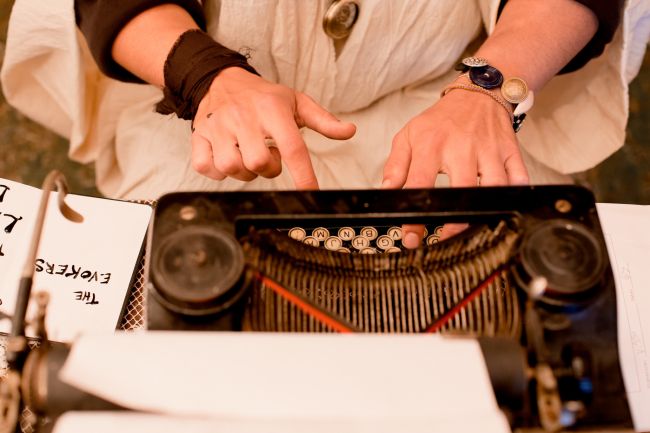
One of the Evokers. Photo: The i of Sisters Academy, Sisters Hope. Diana Lindhardt
"These things signify that you're making an effort.", Gry says. "We need to stop people short in their 'experience economy shopping'.""
"Many consumers of experiences have become spoiled.", she continues. "...They believe they can just show up and have some great experience handed to them. But honestly I don't think that's when the deepest spaces open up. Art can open far deeper spaces but it requires our own investment. Otherwise it doesn't move anything in us."
Aside from Savage Amusement, the laboratory is inhabited by Kata Halasz, Sisters Hope and Lilibeth Cuenca Rasmussen, the latter being the performer inside those twenty-seven layers of snakeskin.
The laboratory is not only a site for conducting experiments on participants. It is also a curatorial experiment in itself. The curatorial novelty of the Performance Sense Laboratory lies in the construction of an immersive performance installation which, while being a work of its own, serves as a common framework for several individual performance groups. Gry is very happy with this novel approach.
"The laboratory is a bit like a letter case.", she says of the composite quality of the installation. "Each room is another bin in the letter case where the inhabitants interpret, in each their own way, this question about the sensuous. Which room opens you, which room sets you free, that depends who you are."
To Melanie Jame Wolf of Savage Amusement, this way of working together was an interesting experiment in itself:
"Our knowledge of one anothers' work within the Performance Sense Laboratory was all communicated via the participants.", she says. "The different imprints and inflections of what they had experienced in other rooms and how that informed what we did. In that way, it was a purely affective or sensuous mode of collaboration and it was interesting to tune into what that meant and how that could work."
"No single performance constitutes its own narrative.", Gry explains. "When you encounter them, you have already passed through several other rooms. It all comes across as one narrative."

Mobile Mirrors, by Lilibeth Cuenca Rasmussen, the Performance Sense Laboratory. Photo: The i of Sisters Academy, Sisters Hope. Diana Lindhardt
I shall remain curious about the results of the experiments in this laboratory, but I am sure they will be ardently put to use by Gry Worre Hallberg in her ever expanding work with Sisters Hope, the performance group developing the school of the sensuous society. Earlier this year, Sisters Hope took charge of a Danish school for a fortnight and later in the year, having spent the summer doing experiments at Roskilde, they are taking the sensuous society to a school in Malmö, Sweden. The sensuous society is beginning to happen in our reality.
A Stroll Through The Art Zone
The Performance Sense Laboratory is four artworks within one artwork. It is itself part of a greater artwork - the Art Zone - home to all of the festival's art activities. A supreme gesamtkunstwerk containing pieces and events in the realms of visual art, performance, architecture, installation, gaming, food and journalism.
"We had to gather it all together to make some noise. We had to give people a 'whoa' feeling before they even enter. We've likened it to Coney Island or St. Peter's Basilica. Places where you walk in and feel really small and awed.", curational co-director Daniel Toke Hansen says.
I do see his point. Maser's enormous brightly coloured blocks certainly catch the eye. And the tall scaffold structures make the place seem like a surreal castle, or a mirage in the summer heat.
In one wing of this dream castle, a game is played in a dark room, staged by Die Gute Fabrik. The players hold on to coloured lights hanging from the ceiling. The colours change and the players must swing between each other and grab on to new lights.
In another wing, on a stage facing outward from the Art Zone, the journalist collective Zetland is hosting artist talks and events starring some of the festival's music artists. The wooden stage they're on was built for the occasion by designers Maria Legaard Kjeldsen and Reffelt/Brøgger. It was designed to address one of the core components of the festival: meetings between people. The stage is very open, integrating smoothly into the landscape to the front as well as the back but still maintaining a clear distinction from the world around it. This cooperation between designers and journalists is a succesful one. The lively Zetland journalists and their short and pleasant events seem completely at home on this stage.
The stage for journalism at the festival. The white crown on top signifies that something is happening on the stage. When the stage closes, the crown is folded in
"We would like to facilitate meetings and to challenge the way people meet.", Fie Reffelt says.
Part of this challenge consists of a couple of innocent-looking chair arrangements in another part of the Art Zone. They look like they can be swiftly rearranged but actually they are immovable.
"You get to sit together in really unusual positions. You have to work hard to sit the way you want.", Maria Legaard Kjeldsen says. She's right.
Interaction is the holy grail here. What a chance, what a privilege for these artists to make art of interaction! Back in Copenhagen, people do their own interacting and artists make exhibitions. If an artist tries to make interactive art there, he's lucky to have visitors. And the interaction will often be forced ('Look, I'm interacting with some art!'). That's all different here. With no everyday routine, no established comfort zone and no clear border between life and art, everyone is left prey to the interactive art.
"The festival is an experimentarium.", Gry Worre Hallberg comments. "In terms of curatorial approaches too."
One day, I walk into the Art Zone and a pop-up event is happening, staged by the art and curating group KURATO. People are being made into sculptures. They are made to squeeze into carved cardboard boxes, alone or in groups of two and three, and stick their heads out on top. Then they are photographed for social media.

Man becoming sculpture?
"People here are almost a hazard to themselves.", curator Daniel Toke Hansen comments. "Anything they can join in, any activity they're invited to do, they'll do it. People throw themselves into all these events and come out changed."
Maser's Maze
The middle of the Art Zone consists of an arrangement of large vertical square panels painted in Maser style bright colours and diagonal lines.
"Yeah, it's a labyrinth", the artist says.
"I built a labyrinth so that people interact with the artwork. Rather than just look at it, they get involved with it. That excites me, you know. I'm putting in a public space and they can enjoy it."
People do seem to be enjoying Maser's labyrinth in the summer heat. The sizeable shades cast by the large panels take part of the credit for that, though.
"It's about interrupting space and landscape and that's what graffiti does, you know.", Maser further elaborates. "Someone goes to work every day with the same routine and one night a graffiti writer comes and does graffiti on the wall, and how that interrupts that flow. That's what I use the stripes to do - to communicate that. The physical context here is great for me because it juxtaposes the natural environment with this clean vector synthetic artwork. They contrast each other so much that they complement each other."
The colours on these walls are numerous and very unreal, like 1980's video games or Alice In Wonderland. They seem to exert a strange fascination on the eye. You can catch yourself staring at them for minutes.
Maser's labyrinth
"It's the contrast, you see.", Maser explains. "I always start with yellow. That's my source. And then I'll always put a constrasting colour. Yellow is a warm colour, so I'll always put a cold colour beside it to make contrast. Then it's like a process of elimination. I try never to put two similar colours together."
During the festival, Maser's crew films the festival goers' interactions with the labyrinth. The footage will become a video which will be published on Maser's website.
Social media are important to Maser and have even begun to shape his work:
"I embrace it fully. This is what public art is. It's there to be shared.", he says. "Because it's quite clean and square,", he explains, pointing towards one of the walls, "...people end up using it as a backdrop. It fits quite well with an Instagram space. It's just a nice background that people use quite a lot. They share it quite a lot. I understand that there's a big importance to that, compared to 20 years ago."
Unlike the performance groups who wish to do research on the festival guests, the gamers who wish to enroll them in their games and the construction designers who want to challenge their sitting and meeting conventions, Maser does not have a plan for the festival guests. He has built a public space and handed it over to the public.
"Literally it's for them to do what they want with it.", he assures.
How To Eat Music
On another rim of the Art Zone, a strange piece of furniture is standing around. It's a big cupboard with a dining table on top of it. Two women in white are standing by the staircase leading up to the table, looking slightly mischievous.
This is "The Furniture of Meals", I am informed. A work of art within the rare genre of "Food Performance". The next session is fully booked, but I hang around just in case someone misses their appointment, which is almost completely certain at Roskilde Festival - infamous for stranded plans, oceanic crowds and bad phone connections. Sure enough, three of twelve participants fail to show up and I take a seat and greet my dinner companion. We're a dinner party of twelve and neither of us have met before.
What's on the menu? Bands from the festival line-up.
The performance works like this: At each person's seat is a drawer. When the bell rings, everyone opens his drawer. One of them contains a meal. That person must then taste the meal and explain the taste to the others. Together, we must then figure out which band the meal represents.
Off we go. The bell rings. A meal appears in the drawer of the woman across from me. It's a thick, reddish liquid.
Whoa, this is pungent...", she says, making a surprised face.
"It's something with tomatoes... it tastes smoked."
"It's quite heavy..."
Before too long, we have guessed that it's The Rolling Stones. The person who guessed it is awarded a cookie in her drawer by the kitchen staff working from inside the cupboard below.

Cross-section of The Furniture of Meals. Photo: Christine Overvad Hansen and Augusta Sørensen
Next up, I am treated to a sticky and dense cake shaped like a samba dancer's firm butt. She's wearing a green thong made of frosting. It tastes like a dance party and indeed it's Major Lazer.
So the performance continues. We talk around the table and connect meals to bands. Some are easier to guess than others. Sometimes we need hints. They too are delivered through the drawers as pictures or objects.
"It's being present while eating", Christine Overvad Hansen tells me. She runs The Furniture of Meals with her chef companion Augusta Sørensen.
It's also a rare form of synaesthesia. Eating bands. Taste and sound. And it's more than that. The Furniture of Meals turns food into a language. Christine expands on the metaphoric qualities of this new language:
"Normally, we define taste as sweet, salt, bitter, fat or umami but it could be something entirely different. You could have a creamy asparagus soup so silky soft you just want to hug it like a big-bosomed, red haired woman. We collect that kind of tastes. We have a little toolbox full of them."
The Art of Falling Apart and The City of Dreams
Urban garden at Dream City
The Art Zone is great. But I'm not sure I approve of the decision to gather all the art there. I miss the recklessness of last year's festival where you could suddenly find yourself in the middle of a political happening by VOINA and where the works of temporary architecture produced by the 72 Hour Urban Action competition were integrated into a large area in the camping zone. There was something enchanted about the way the art just popped up and no one could be sure to avoid it.
But then again, it's a thin line between the official art activities in the art zone and the general artfulness of simply being here. Each festival person is her own work of art. We fall apart for a week, each in our own way.
When we lie down on the grass with the 5th beer of the day, randomly together with a good friend, a faint acquaintance and a complete stranger, listening to a weird band we don't even like.
When we space out for an hour in the sunlight, not saying a word but listening to one hopeless piano player after the other struggling with the piano that's been set up out there on the grass.
Somewhere on that thin line lies Dream City. The concept of Dream City is that you can build anything you dream of. The pioneers of this city arrive months early to construct their masterpieces. This year, there is a church, a mail office, an urban garden and a library, just to name a few of the materialized dreams. On a small hill behind the city stands the "DREAM CITY" sign, calling to mind the notorious Hollywood sign. By the end of the festival, the sunsets are framed with the silhouettes of human beings pluming these letters like butterflies on the horizon - sitting in the D, leaning on the A, climbing onto the E.
At the front of Dream City, a workshop is being run by the DIY platform Don't Fear Tools. People are building their own chairs and painting them creatively. The workshop leader says she wanted to teach people that they can build something new. She is happy. The workshop is buzzing.

Happy women building a chair in Dream City
Next door, "Start Me Up", run by DITwerk, offers coaching to anyone who has an idea. Aside from helping through advice, they have built an imaginarium to help the ideas spring up. It's full of mirrors and video art is playing on the far wall.
Just across from this sanctuary of ideas, the very smallest stage of the Roskilde Festival is waiting for its next act. Set up by a theatre collective called De Umiddelbare ("The Spontaneous Ones"), it hosts shows by whoever happens to pass by. The schedule is almost full: music, poetry, impro, rap battle... Some of the people involved work with theatre outside the festival as well, but some others inform me they have never done anything of the sort but are simply involved in organizing this now because they happened to be camp mates wtih the theatricalists. They're living the dream.
A perfect setting for whatever comes up. By De Umiddelbare. Dream City
The Sun Sets
Of course there was lots of other art at the festival which I haven't written a word about. There were murals by HuskMitNavn. There was a "gif-iti" by INSA and an installation by Ungt Lys. But it seems pointless to even write about all this non-interactive art. It drowns in the wild context of the festival. Actually, INSA's piece does a great job spelling out just how extreme the festival context is. In its native street context, INSA's gif-itis would be an ambassador of flashy vitality like David Bowie in the Soviet Union. In the buzz of the festival, it becomes the opposite. Standing still in a whirl of movement, standing small and square in a city of strangely shaped structures, it looks more like a communist at a burlesque party.
But you forget this. You forget how extreme this festival is that you're in the middle of. You jump into the festival like cold water. When you arrive with your tent and your backpack, tired after the journey there, it's a shock. Your instincts tell you to escape. But after a while, the water seems less cold. And before long you'll have forgotten that it's cold at all. You'll be waving at your friends to come jump in.
The artists have various musings on the good and bad sides of working in this sea:
"It's challenging to work here," performance artist Lilibeth Cuenca Rasmussen says, "...because people aren't sure how to approach my performances. When I did the Skin Stripping performance, one of the spectators started stripping along with me. And that's not what I'm after at all. But it's also interesting to get out of my comfort zone a bit. Back in the Copenhagen art world, I feel very, very safe..."
Interaction! Mobile Mirror with festival guest. Roskilde Festival is a unique and precious context for interactive art
"For a street artist or a graffiti writer, it's really a Mecca.", Maser says. "It's the best place to come because you get all the best in Europe coming here. So you get an amazing opportunity to hang out with some amazing artists, paint with them and learn from them. And then other opportunities arise from it. There are 100,000 people here. And from that I occasionally get an opportunity to go to another country."
Gry Worre Hallberg appreciates the experimental quality of the festival: "Everything's an experiment here," she says, "...because you can't try it out before you do it. And every year the setup changes. So you can never be sure it's gonna work."
Johan Kjærulff Rasmussen is responsible for the identity of the Art Zone and for coordinating the actions of the various curators. I talk with him after the festival to draw up this year's wins and losses.
"I thought the Art Zone was very well received by the festival people.", he says. "They appropriated the place. They played to the artists' tunes. They invested themselves and took part in all our various art projects."
"As a festival, it is our express goal to move and to challenge people, culturally as well as politically.", Johan states. "I think it's obvious that art can contribute to the achievement of this. We engage the audience and offer them art experiences they could not possibly have outside the festival."
Johan also comments on the difficult balance between unity and multitude in a place like the Art Zone:
"Hopefully it functioned as one gesamtkunstwerk within which the individual artworks stood out distinctly".
Everybody involved has a clear opinion on what it's like to work at Roskilde. The opinions vary, but there are some words never said: "boring", "simple" and "ordinary".
The most enthusiastic of all the artists might just be Maser.
"I wish the whole world was like this", he says. A wish he no doubt shares with ten-thousands of young Danes who are still walking around aimlessly, trying to settle in the real world, just as dizzy as I was after walking out of the fox room.
